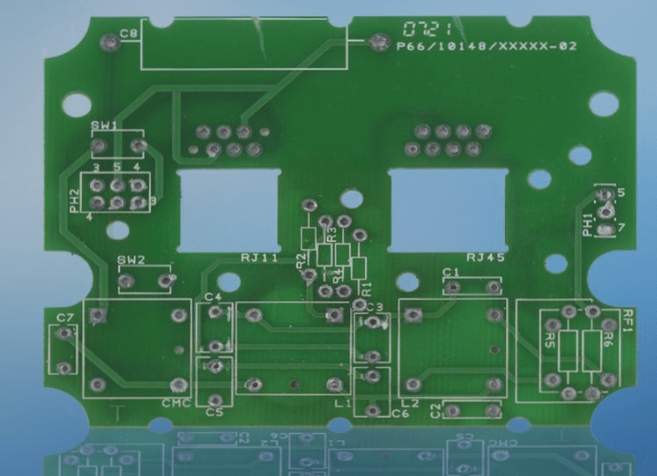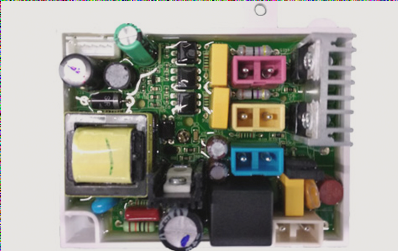To promptly identify faults in PCB manufacturing, this article examines common causes of PCB failures, integrates circuit knowledge, and presents a set of practical PCB fault detection procedures along with four sequential principles derived from extensive experience. Finally, it summarizes the development trends in PCB fault detection methods and technologies.
1 PCB and Analysis of Common Failure Factors
1.1 PCB Overview
PCB stands for printed circuit board. It involves etching connections between various components onto a copper-clad substrate through a series of processes. This approach ensures consistency among electronic components, eliminates manual wiring errors, enables automatic insertion and placement of components, facilitates automatic soldering, and allows for automatic detection. These advantages enhance the quality of electronic devices, boost labor productivity, lower costs, and simplify maintenance.
1.2 Analysis of Common Failure Factors of PCB
As circuit complexity and component integration increase, various failures are bound to arise during the production and usage of circuit boards. Based on extensive practice, this article identifies the main failure factors as follows:
1) The circuit board layout is inadequately designed, leading to electromagnetic interference from wiring and nearby components;
2) Damage to circuit board components prevents the system from functioning correctly;

3) The performance of the components is unstable due to inherent issues, leading to unreliable operation of the equipment;
4) There is no damage to the components of the electronic equipment, and the inability to operate stems from issues like solder joints, which can cause circuit openings or shorts.
2 The general process and principles of PCB fault detection
2.1 What should be done before PCB fault detection
1) Understand the working environment of the equipment, primarily considering the potential impact of external electrical parameters;
2) Inquire about the specific failures experienced by the circuit board and analyze the root causes;
3) Carefully inspect the components on the circuit board to identify which ones are critical;
4) Implement measures to mitigate electromagnetic interference and static electricity.
2.2 The general process and principles of PCB fault detection
2.2.1 From manual observation to instrument measurement: “look first, then measure”
The components in electronic devices and the wiring between them are largely located on the surface of the circuit board. When a circuit board malfunctions, start with a visual inspection. For improved accuracy, employ tools such as microscopes or magnifying glasses. Instruments can aid in pinpointing problems more precisely. Regardless of the method used, focus on identifying the following:
1) Whether the connections between PCB components are intact and if power, ground, and other specific points are functioning properly;
2) Whether the pins of integrated chips, diodes, transistors, resistors, electrolytic capacitors, inductors, and other components have any loose or erratic connections;
3) Whether there are operational issues in the solder joints of each component, such as cold solder joints, missing solder, or incorrect pin insertion.
2.2.2 From the periphery to the inner layer: “first the outside, then the inside”
Given that component-related failures account for the majority of circuit board issues, efficiently identifying problematic components is crucial.
2.2.3 From simple to complex: “easy first, complex later”
In the PCB fault detection process, employ various testing techniques, adhering to the principle of “easy first, complex later.”
1) Pre-testing measures
Circuit board simulation is an effective design tool that significantly reduces design cycles and costs, but it relies on ideal conditions for each component, neglecting various real-world interferences. Consequently, shielding against different types of interference before testing is critical. Common shielding methods include short-circuiting the crystal oscillator. Additionally, because the charging and discharging of capacitors can induce interference, soldering a pin to large electrolytic capacitors can help maintain them in an open circuit state. To prevent any impact on the CPU during testing, it should be removed.
2) Applying “easy first, complex later” to specific detection methods
Component inspection typically begins with simpler components and progresses to more complex ones, as simpler components are generally easier to troubleshoot. During device testing, use an exclusion method—test each component one at a time while keeping records. If a test fails, retest for accuracy; if it still fails, document the result before proceeding to the next component. Components that fail testing can be treated as key suspects.
3) Supplementing different testing methods
Relying solely on one testing method may not reveal all faults. Start with simpler techniques; if problems are not identified, more advanced methods should be employed as a supplement. PCB testing has evolved through manual visual inspection (MVI), online testing (ICT), and boundary scan technology (BST), with non-vector testing methods now added.
2.2.4 From static detection to dynamic detection: “static first, then moving”
One approach involves measuring the voltage at the pins. For different pins, the voltage values should differ when the circuit board is powered normally. However, various factors, such as pin sensitivity and adjacent component faults, must be considered. Another approach is to measure resistance online. Given that ICs use direct coupling, the DC resistance between other pins of the IC and the ground pin is relatively stable. This internal DC resistance can be measured with a multimeter to assess each pin’s status. If the measured resistance matches the reference value, the integrated circuit is functioning normally; if it diverges significantly, it suggests an internal issue with the chip that may require replacement. In testing, online voltage and resistance measurements are often used in tandem.
3 Concluding remarks
Currently, PCB testing technologies that integrate multiple disciplines are becoming increasingly diverse. Each technology has its specific applications; for instance, online testing is constrained by the device test library, while boundary scan methods have strict requirements for reference circuit boards. Therefore, to enhance the accuracy and efficiency of PCB fault detection, practitioners should refer to the general processes outlined in this article and adhere to the four detection principles. By flexibly utilizing various testing techniques, PCB fault detection can become more automated, intelligent, and efficient.
1 PCB and Analysis of Common Failure Factors
1.1 PCB Overview
PCB stands for printed circuit board. It involves etching connections between various components onto a copper-clad substrate through a series of processes. This approach ensures consistency among electronic components, eliminates manual wiring errors, enables automatic insertion and placement of components, facilitates automatic soldering, and allows for automatic detection. These advantages enhance the quality of electronic devices, boost labor productivity, lower costs, and simplify maintenance.
1.2 Analysis of Common Failure Factors of PCB
As circuit complexity and component integration increase, various failures are bound to arise during the production and usage of circuit boards. Based on extensive practice, this article identifies the main failure factors as follows:
1) The circuit board layout is inadequately designed, leading to electromagnetic interference from wiring and nearby components;
2) Damage to circuit board components prevents the system from functioning correctly;

3) The performance of the components is unstable due to inherent issues, leading to unreliable operation of the equipment;
4) There is no damage to the components of the electronic equipment, and the inability to operate stems from issues like solder joints, which can cause circuit openings or shorts.
2 The general process and principles of PCB fault detection
2.1 What should be done before PCB fault detection
1) Understand the working environment of the equipment, primarily considering the potential impact of external electrical parameters;
2) Inquire about the specific failures experienced by the circuit board and analyze the root causes;
3) Carefully inspect the components on the circuit board to identify which ones are critical;
4) Implement measures to mitigate electromagnetic interference and static electricity.
2.2 The general process and principles of PCB fault detection
2.2.1 From manual observation to instrument measurement: “look first, then measure”
The components in electronic devices and the wiring between them are largely located on the surface of the circuit board. When a circuit board malfunctions, start with a visual inspection. For improved accuracy, employ tools such as microscopes or magnifying glasses. Instruments can aid in pinpointing problems more precisely. Regardless of the method used, focus on identifying the following:
1) Whether the connections between PCB components are intact and if power, ground, and other specific points are functioning properly;
2) Whether the pins of integrated chips, diodes, transistors, resistors, electrolytic capacitors, inductors, and other components have any loose or erratic connections;
3) Whether there are operational issues in the solder joints of each component, such as cold solder joints, missing solder, or incorrect pin insertion.
2.2.2 From the periphery to the inner layer: “first the outside, then the inside”
Given that component-related failures account for the majority of circuit board issues, efficiently identifying problematic components is crucial.
2.2.3 From simple to complex: “easy first, complex later”
In the PCB fault detection process, employ various testing techniques, adhering to the principle of “easy first, complex later.”
1) Pre-testing measures
Circuit board simulation is an effective design tool that significantly reduces design cycles and costs, but it relies on ideal conditions for each component, neglecting various real-world interferences. Consequently, shielding against different types of interference before testing is critical. Common shielding methods include short-circuiting the crystal oscillator. Additionally, because the charging and discharging of capacitors can induce interference, soldering a pin to large electrolytic capacitors can help maintain them in an open circuit state. To prevent any impact on the CPU during testing, it should be removed.
2) Applying “easy first, complex later” to specific detection methods
Component inspection typically begins with simpler components and progresses to more complex ones, as simpler components are generally easier to troubleshoot. During device testing, use an exclusion method—test each component one at a time while keeping records. If a test fails, retest for accuracy; if it still fails, document the result before proceeding to the next component. Components that fail testing can be treated as key suspects.
3) Supplementing different testing methods
Relying solely on one testing method may not reveal all faults. Start with simpler techniques; if problems are not identified, more advanced methods should be employed as a supplement. PCB testing has evolved through manual visual inspection (MVI), online testing (ICT), and boundary scan technology (BST), with non-vector testing methods now added.
2.2.4 From static detection to dynamic detection: “static first, then moving”
One approach involves measuring the voltage at the pins. For different pins, the voltage values should differ when the circuit board is powered normally. However, various factors, such as pin sensitivity and adjacent component faults, must be considered. Another approach is to measure resistance online. Given that ICs use direct coupling, the DC resistance between other pins of the IC and the ground pin is relatively stable. This internal DC resistance can be measured with a multimeter to assess each pin’s status. If the measured resistance matches the reference value, the integrated circuit is functioning normally; if it diverges significantly, it suggests an internal issue with the chip that may require replacement. In testing, online voltage and resistance measurements are often used in tandem.
3 Concluding remarks
Currently, PCB testing technologies that integrate multiple disciplines are becoming increasingly diverse. Each technology has its specific applications; for instance, online testing is constrained by the device test library, while boundary scan methods have strict requirements for reference circuit boards. Therefore, to enhance the accuracy and efficiency of PCB fault detection, practitioners should refer to the general processes outlined in this article and adhere to the four detection principles. By flexibly utilizing various testing techniques, PCB fault detection can become more automated, intelligent, and efficient.




